Oze (ö÷ÉŻ) is a national park and excellent hiking destination in the mountains about 150 kilometers north of Tokyo. Its most well known features are the Ozegahara Marshland and the Ozenuma Pond. A number of surrounding mountains are also included within the park. Oze is very popular during the blooming of skunk cabbages in the late spring and during the fall colors of early autumn, whereas in the winter it is covered in deep snow and is rarely visited.
Oze has numerous trailheads through which visitors can enter the park. The trails are well maintained, and there are wide, elevated boardwalks that pass over the Ozegahara Marshland and around Ozenuma Pond. Hiking from the Hatomachitoge trailhead past the marshland and pond to the Oshimizu trailhead can be done in six to eight hours by decent hikers, and there are no overly difficult inclines.
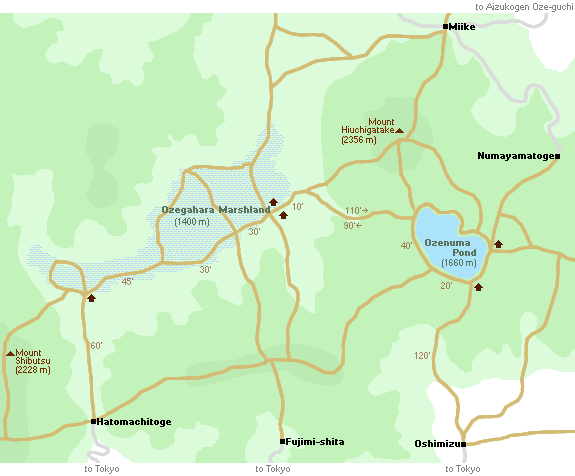
The park can be visited in a day trip from Tokyo, but to avoid an early start and a lot of traveling in one day it is also possible to stay overnight. Within the park grounds there are a few mountain huts where travelers can stay for the evening. Accommodation can also be found just outside the park in the Tokura area, from where buses depart to the southern trailheads.
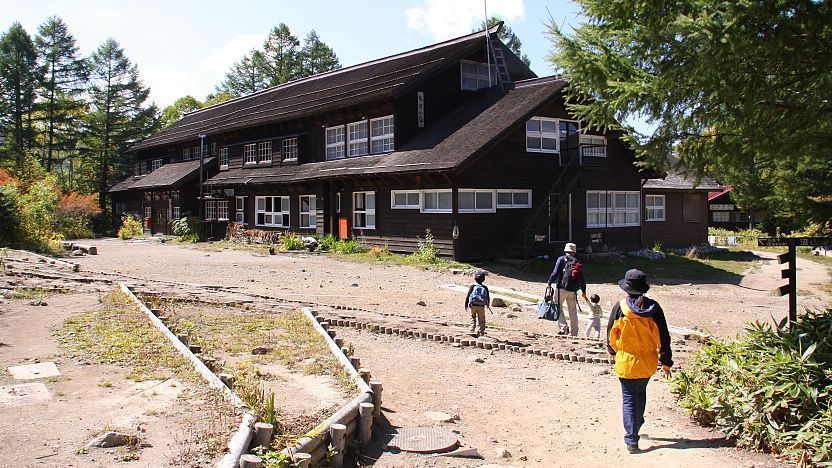
The Ozegahara Marshland, located about 1400 meters above sea level, is the most popular area of the park. It is about six kilometers long and one kilometer wide, and has hundreds of small, distinct pools. When walking the length of the marshland, the two mountains Shibutsusan and Hiuchigatake seem to hover over hikers at either end of the paths. The Hatomachitoge trailhead is only a one hour walk from the western end of the marshlands, and therefore the most popular among the trailheads.
The most famous image of Oze is of the white skunk cabbages in bloom across the marshlands in late May and early June. The marshland also becomes very attractive in late July and early August when the yellow alpine lilies are in bloom and during the autumn colors in late September and early October when the grasses of the marshland turn bright yellow and red.
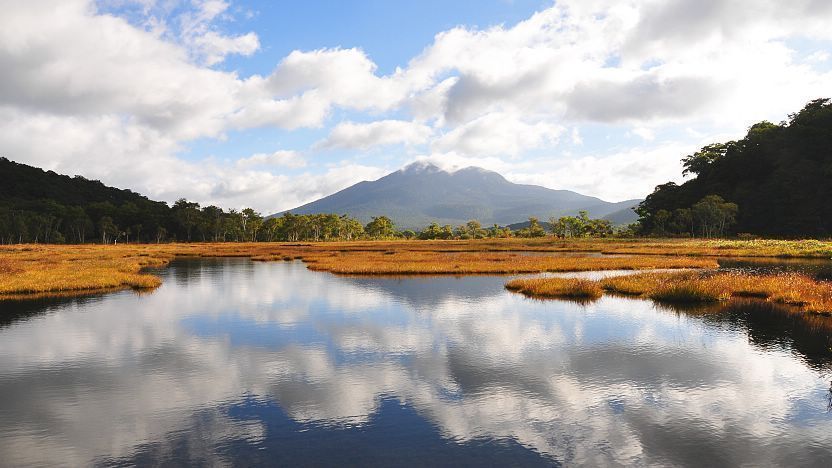
The park's second most famous feature is the Ozenuma Pond, which can be reached from the eastern end of the Ozegahara Marshland in about an hour and a half along a trail through the woods. There is a six kilometer path that leads around the entire pond and sometimes runs alongside the water and sometimes through the forest. Oze's famous flowers can also be found near Ozenuma in small marshlands near the pond.
Until 2007 most of Oze National Park was part of the nearby Nikko National Park. When Oze received its own separate national park designation, a few nearby mountains were added to the park grounds. Although the vast majority of the park lies within the two prefectures of Gunma and Fukushima, there are small sections that extend into the neighboring prefectures of Niigata and Tochigi so that Oze stretches across four different prefectures.
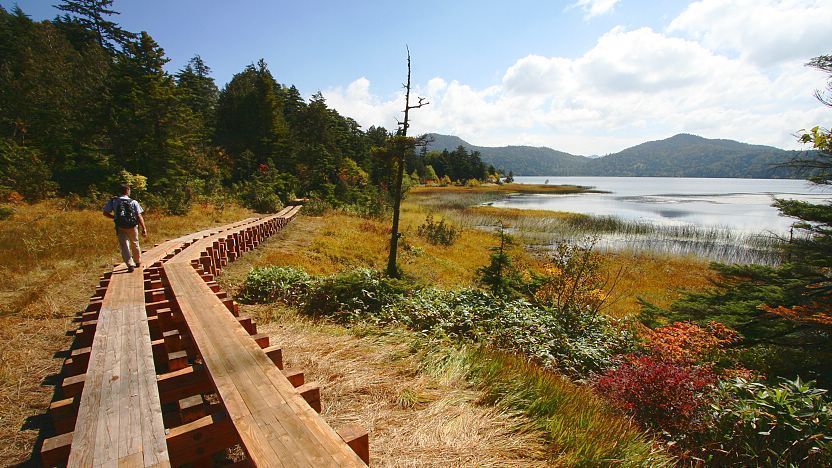
Getting there and around
There are two main approaches to Oze National Park: one from the south through Gunma Prefecture and one from the north through Fukushima Prefecture. For visitors coming from Tokyo, the approach through Gunma Prefecture is much more convenient.
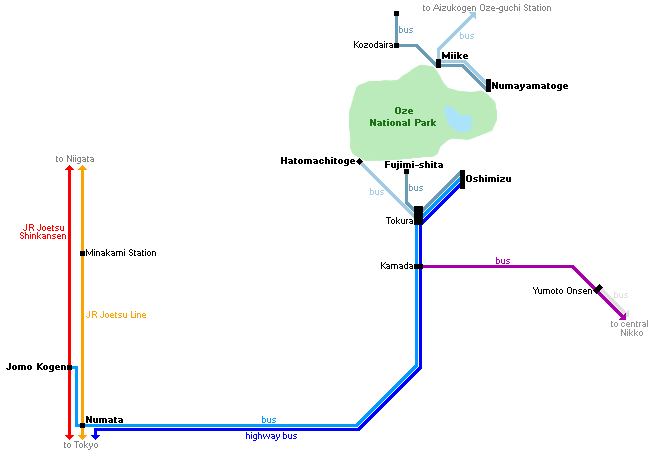
From Tokyo via Gunma Prefecture
There are three major trailheads on the Gunma side of Oze:
Most popular is the Hatomachitoge trailhead because of its proximity to the marshland, a one hour walk away. The road to Hatomachitoge is closed to private vehicles, and shuttle buses operate to Hatomachitoge from Tokura from mid April to early November (April 19 to November 4, 2024, 1300 yen one way), where there are several large parking lots (1000 yen per 24 hour period) and bus connections to/from Numata and Tokyo.
The second most popular trailhead is the Oshimizu trailhead because of its proximity to Ozenuma Pond, a two hour walk away. In contrast to the road to Hatomachitoge, the road to Oshimizu remains open to private vehicles during the entire hiking season. Many buses from Numata and Tokyo run all the way to the Oshimizu trailhead between mid May and mid October (the others terminate at Tokura).
The third trailhead, the Fujimi-shita trailhead is the least popular, because it is not convenient for accessing either the marshland or the pond. The road to the trailhead remains open to private vehicles during the entire hiking season.
By train and bus
From Tokyo, three types of trains can be used to reach Oze National Park: the JR Joetsu Shinkansen to Jomo Kogen Station (around 75 minutes, about 5500 yen, 1 train/hour), the Joetsu/Hokuriku Shinkansen to Takasaki followed by a local train ride to Numata Station (around 2 hours, about 5000 yen) or local trains all the way to Numata Station (around 2.5 hours, 2640 yen, one transfer at Takasaki). All of the above trains are covered by the Japan Rail Pass, JR Tokyo Wide Pass, JR East Nagano Niigata Area Pass and JR East Tohoku Area Pass.
From Numata Station, there is at least one bus per hour to Tokura (80 minutes, 2400 yen), with many continuing on to the Oshimizu trailhead (95 minutes, 2600 yen). Only a few of the buses also serve the shinkansen station, Jomo Kogen Station (110 minutes, 2800 yen to Tokura or 120 minutes, 3000 yen to Oshimizu). For Hatomachitoge, change to a shuttle bus at Tokura.
By direct bus
From late May to mid October, Kanetsu Kotsu operates three highway buses per day (including one overnight bus) between Tokyo (Busta Shinjuku) and Oze (Tokura and Oshimizu). The ride takes about four hours and costs 4200 or 4700 yen one way depending on the day of travel.
By rental car
Rental cars can be acquired at Jomo Kogen Station, Numata Station and Takasaki Station. A rental car allows travelers to combine the trip to Oze with other sites, such as Minakami Onsen or Nikko, which is only 30 kilometers away along National Route 120.
From Nikko
From early June to late October (June 1 to October 27, 2024), there are infrequent bus connections between Nikko and Oze. The buses operate between Yumoto Onsen in Okunikko and Kamada at the entrance to Oze. The one way ride takes one hour and costs 2150 yen.
From Fukushima Prefecture
When approaching the park from the north, the Numayamatoge trailhead is most convenient for accessing Ozenuma Pond (about a one hour walk away), while the Miike trailhead is most convenient for accessing Ozegahara Marshland (about a two hour walk away). A parking lot is located at the Miike trailhead, however, the road between the Miike trailhead and the Numayamatoge trailhead is closed to regular cars (shuttle buses run between Miike and Numayamatoge and cost 600 yen one way). In addition, a bus from Aizukogen Oze-guchi Station on the Aizu Railway Line runs via the Miike trailhead to the Numayamatoge trailhead (2 hours, 2450 yen, 4 buses per day from May through October).
Questions? Ask in our forum.



